German company Bullyand seem to be slipping off the radar a little bit in recent years but still continue to provide new releases every twelve months for their Museum Line, although in rather small quantities. 2011 saw two new figures released by Bullyland, both resculpts of previously produced species. The first, a controversial feathered Dilophosaurus, is one we should review soon and will no doubt generate some…interesting discussions. The second is that most popular of pelycosaurs, the sail-backed Dimetrodon.
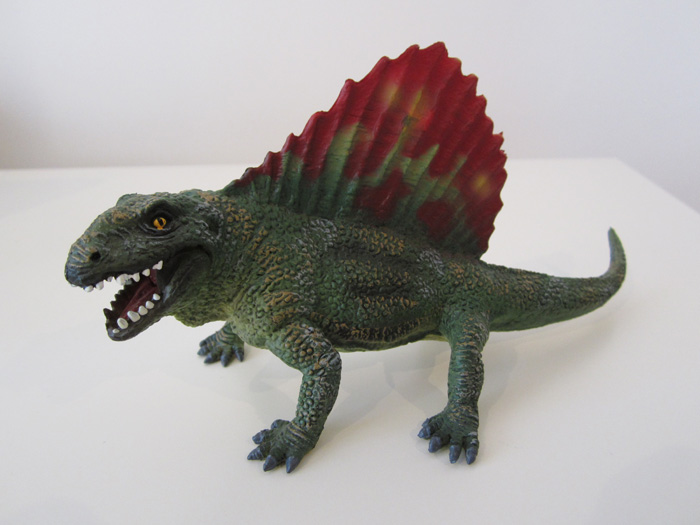
The previous Bullyland incarnation of Dimetrodon seems to have been produced in two paint versions, a rather plain green-grey version, and a more striking deep green with a red sail. The 2011 paint scheme is almost identical to the latter, with a stunning blood-red sail and deep green hues with yellow and gold highlights. Beautiful as it is, it shows a little lack of adventure by picking both a species and a colour scheme visited before.
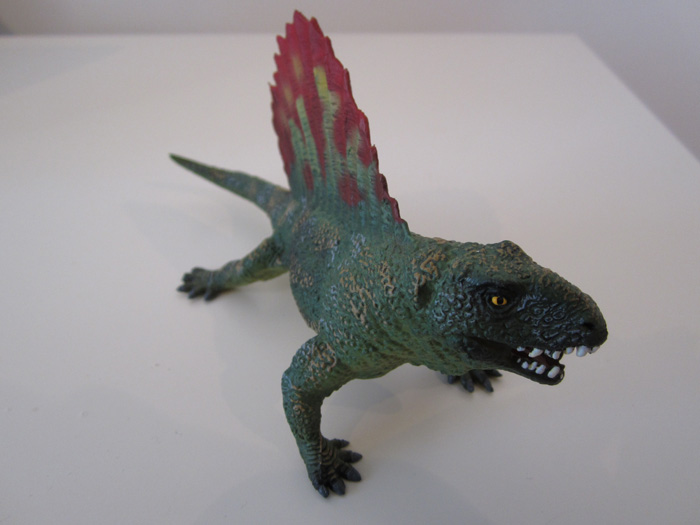
Overall there isn’t that much difference between the old and new versions, the main one being the more upright posture in the 2011 figure. Where the old one was resting lazily on his tummy (I’ll presume it was a ‘he’), the new one is performing impressive push-ups. Despite retaining a sprawling limb posture the new figure is entirely raised up off the ground in a much more active posture.
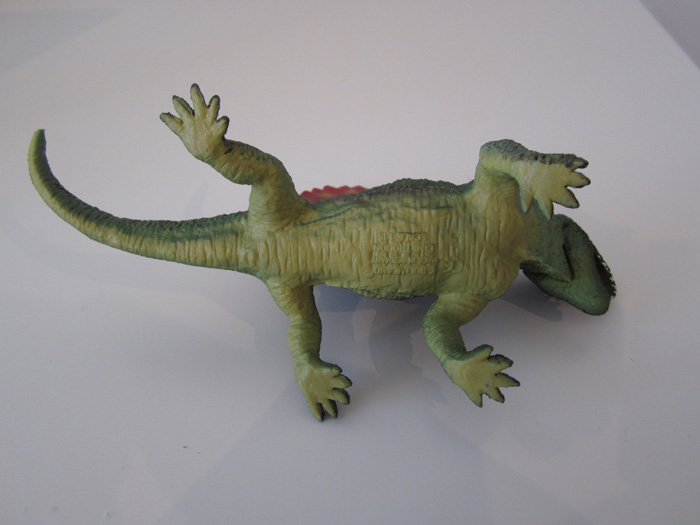
The second major difference is the articulated mandible. This play-feature works well in this figure, but has been a bit hit-and-miss in other Bullyland dinosaurs (I’m thinking of the hip-hop Iguanodon).
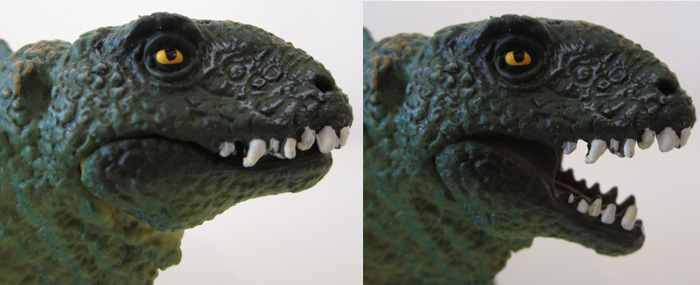
The sculpt is typically and recognisably Bullyland, whatever that means. It has a softness to its appearance that imparts a cartoonish feel, and although visually pleasing from a distance, the textural details are quite crudely rendered for such a large figure. The figure is 18cm long, so pretty big. I’ll point out the ‘blobby’ teeth here. On an anatomical note, the skull lacks the notch in the jawline, that is so distinctive for this species. In its favour, there are depressions behind the skull that represent the ears, and there are five digits in each hand and foot, spot on.
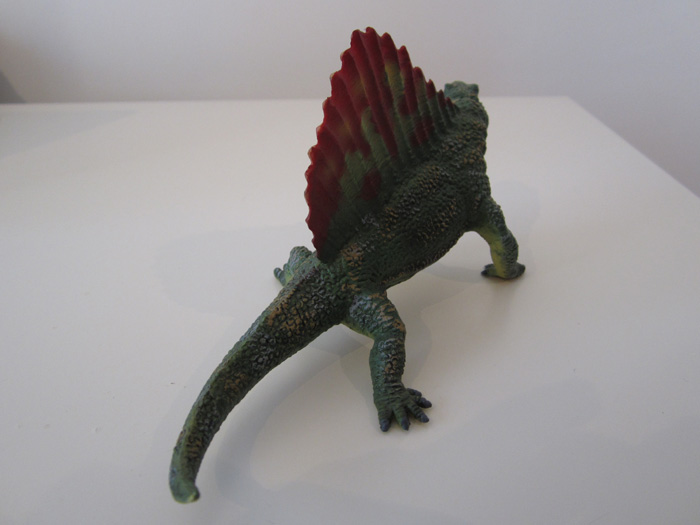
Placed alongside today’s immaculately produced Carnegie, Wild Safari and Papo figures (maybe even CollectA figures in recent months), the ‘Bullyland look’ is starting to look a little old and out of place. As of yet, there is no news on what Bullyland have in store for 2012, but it would be exciting to see Bullyland produce new species rather than ‘play it safe’ with resculpts of old favorites. Let’s watch this space…
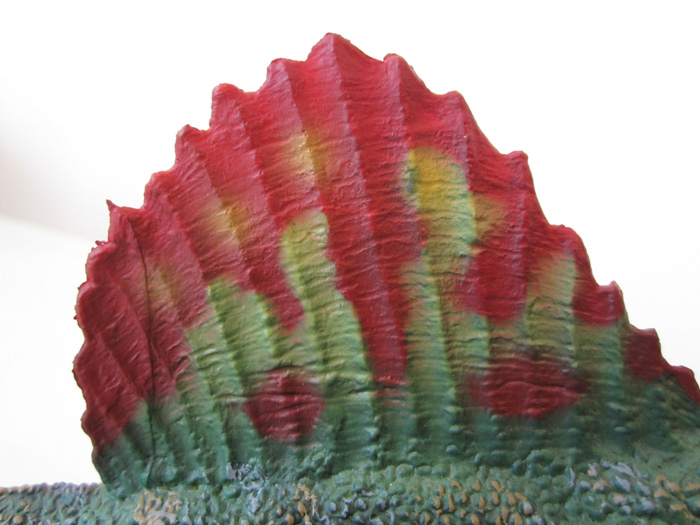
I picked up my Dimetrodon in the small Museum Natur und Mensch on a recent trip to Freiburg, Germany. The Bullyland lines can be difficult to find in the shops outside of Germany. Luckily for us, however, this new representation of the sail-backed Dimetrodon is widely available online (e.g. here)
Disclaimer: links to Ebay and Amazon on the DinoToyBlog are affiliate links, so we make a small commission if you use them. Thanks for supporting us!



bullyand dimetrodon is ok-nothing great, it needs to be more accurate if its supposed to be museum quailty and has stupid eyes-bullyand needs to either make the classic type dinosaur or go full way and make it up to date-the last good bullyand dinosaurs were iguanodon and giganotosaurus-and even they had faults-but bullyland has slipped in quailty and it looks if they arent really trying to had anymore-its shame because the prehistoric animals section of bullyand was really top quailty-even better than carnegie in this view-but there dinosaurs recently are boring cuz i have these 2 models and i dont borther with them at all becasue they arent interesting –
It’s true what they said at the time in the forums that this Dimetrodon Dimetrodon belongs to the subspecies natalis.
For once I’m going to break a lance for Bully seems to me that there has been an improvement over the previous edition, but still have a long way to go. On the other hand though there are other better versions, the company is working but it is not like the expression that put their eyes on the one hand, and other sculptures that could do better, if you access your catalog figures of children’s characters such as Walt Disney and others do it perfectly. Why could not this genius move the dinosaurs and for those who are fans (I’m not) present wild animals?
Anyway its line of mammals now virtually clinched was exceptional for the time he was done.
On the other hand I am not fond of jaws and limbs articulated dinosaur also makes Papo in theropods and figures carnivores makes them look extremely childish.
Haha, I won’t. I’m mostly banging on about this because my post for tomorrow has a bit about the taxonomy of a certain sauropod in it.
I agree that words should be used properly, but in the case of ‘species’, several ways are proper, as it has multiple definitions in the dictionary. I see what you mean though, readers might presume I’m using the strict biological definition when I’m not.
Don’t look up the word ‘dinosaur’ in the dictionary by the way, you’ll probably have heart palpitations 😉
@Plesiosauria While I obviously agree with that to an extent (eg. avoiding ‘order’, ‘superfamily’ (except I didn’t in the last review I edited, whoops), etc.) I think the word ‘species’ should be used in its proper way. Otherwise you could be perpetuating people’s misconceptions about taxonomy, and the relationships between animals more broadly. A lot of people refer to monotypic extinct animal genera as “species” when they wouldn’t dream of doing so with Panthera, Varanus etc. etc.
Well, this little ignoramus is grateful for your terminology concessions, Doctor. 😀
But Adam…the people need to learn!
Yes, but jargon can be a barrier to learning. Therefore I use technical terms when I feel it is appropriate (e.g. http://www.plesiosauria.com/news/index.php/the-name-game-plesiosaur-ia-oidea-idae-or-us/) , and I avoid using them if I feel they aren’t appropriate. Or necessary – if a simpler word does the job just as well, I’ll often use that instead. It’s a gentler approach to learning and I think it fits the Dinosaur Toy Blog just right. So, I sometimes use the word ‘species’ according to its popular definition as opposed to its biological one.
Dimetrodon isn’t a species, it’s a genus.
*runs away*
I know, I know. But I’d rather bug a handful of dino-nerds than confuse 95% of our readers. Everyone knows what I mean when I say ‘species’ in the given context. It means “type or sort (of animal)”. Similarly, I force myself to delete the word ‘taxon’ from every review I write, and replace it with ‘group’, or some similarly unsatisfactory term. It’s why I also classified Kelenken as a non-dinosaur. I’ll let you be our token pedant 😉
Edit:
http://en.wiktionary.org/wiki/species
I’m using definition 1.